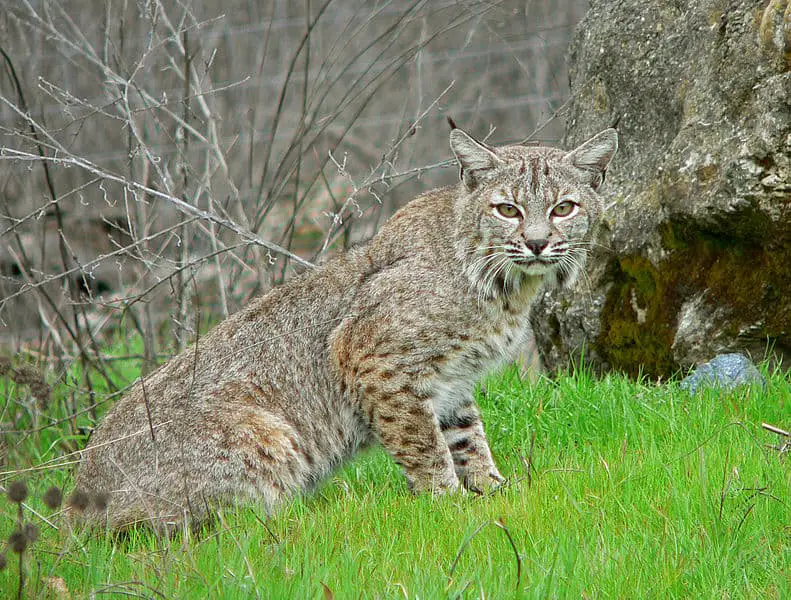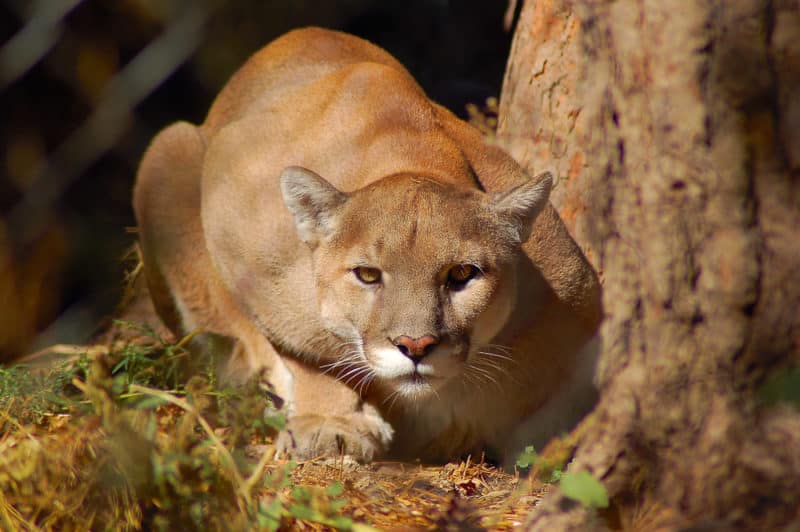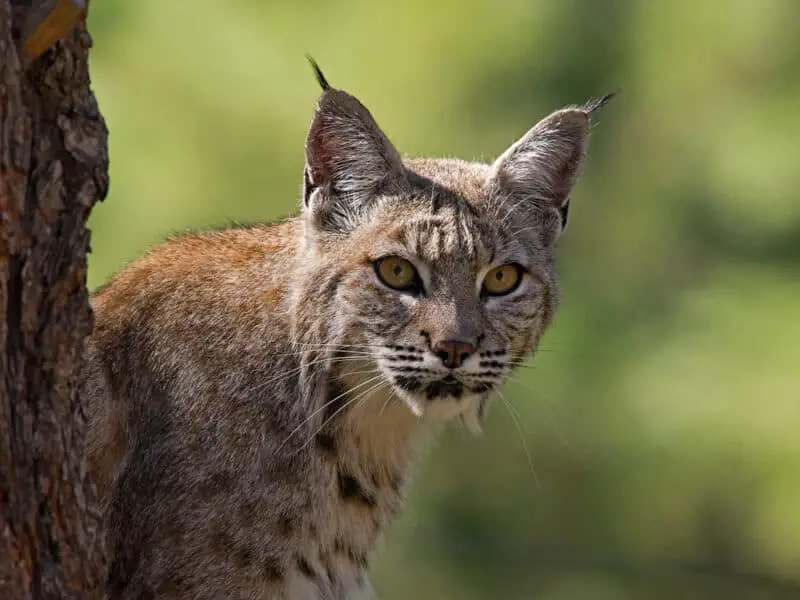Are there wild cats in Louisiana? The answer is yes. Louisiana has bobcats. What’s more, in recent years, there have been several confirmed sightings of mountain lions in the state.
However, the Louisiana Department of Wildlife and Fisheries has determined that despite the documented cougar sightings within the state, Louisiana does not have a breeding population of cougars.
The LDFW also receives calls about black panther sightings occasionally. Black panthers are black jaguars or black leopards. These animals express a melanistic gene and do exist in the wild. If there ever was a black panther lurking in the woods of Louisiana, it would likely be a jaguar. Jaguars actually do live on the North American continent, while leopards are native to Africa and Asia.
Bobcats in Louisiana (Lynx rufus)
The bobcat, which is also known as the red lynx, or the bay lynx, is exclusively a North American wild cat. They are also the most common wild cat species in North America.
Other than feral cats, bobcats are likely the only feline predator with a breeding population within the state of Louisiana.
Biologists believe that both the bobcat and the Canada lynx are descendants of the Eurasian lynx whose ancestors crossed into North America via the Bearing Sea land bridge.
Where do bobcats live?
Bobcats reside only in North America. Their range begins in southern Canada and then extends south through most of the United States and down into central Mexico.
In Louisiana, bobcats live in most areas of the state. People rarely see them, though, because they are mostly a nocturnal or crepuscular animal.
Compared to Canada lynx, which thrive in deep snow country, bobcats struggle more in the snow due to the fact that they cannot walk on top of it like lynx can. A lynx’s oversized large paws function like snowshoes keeping it on the snow’s surface. On the other hand, compared to lynx, bobcats have small feet that tend to sink into the snow. If the snow is too deep and powdery, it reduces their mobility along with their ability to catch prey.
Admittedly, snow is almost never an issue in Louisiana. The commentary on snow is still important in establishing the bobcat’s broader range over the entirety of North America.
Other than their inability to cope with deep snow, bobcats are pretty versatile and tend to utilize all the different habitats within their range. You can find bobcat populations anywhere, from areas with coniferous forests to swamps and semi-forested mountain areas. You’ll even find them in agricultural areas and or urban areas.
In Louisiana, bobcats utilize heavily forested areas, swamps, hardwood covered bottomlands.
Bobcats often use rock crevices as den sites but may also den in the cavity beneath an overturned stump or beneath a blown-down tree,

What do bobcats look like?
An adult bobcat is a bit larger than a large domestic cat, like a Maine coon cat, for instance.
They range from 2 to 3 feet long and weigh from 15 to 35 pounds. Adult male bobcats are quite a bit larger than females.
These animals have a “bobbed,” short tail with black bands on their upper surface. Their tail also has a black tip on its upper surface but not the back. Their fur is usually gray to brown, with mottled black spots interspersed with black lines on their bodies. They also have black stripes on their inner forelegs and tail.
From a side view, you will notice that a bobcat is slightly higher at the rump than at the shoulders. Bobcats and lynx have long hind legs in proportion to their forelegs.
Bobcats have black-tufted, proportionately large ears. In other words, they have short ear tufts of hair that poke up above their ears that are black at the tips. The backs of their ears, below the black tips, are black. In the center of the black of each ear, they have a single white spot. This gives the impression of a false eye on the back of each ear.
They also have a whiskered face that seems broader due to their long ruffled facial hair and whiskers. Their eyes are yellow with round black pupils.
What do bobcats eat in Louisiana?
Despite their comparatively small size, bobcats are aggressive, tough predators. At times, particularly during the winter, they take down prey that is several times larger than they are, such as feral hogs and white-tailed deer. However, their regular diets mainly consist of small mammals such as eastern cottontails, swamp rabbits, eastern gray squirrels, and assorted rodents. They also eat reptiles, birds, insects, and carrion. When they take up residence close to a residential area, their menu might occasionally also include small pets.
They even prey on venomous snakes when the opportunity arises despite not being immune to the venom. They accomplish this by using their quickness to pin the snake’s head down with a paw, after which they dispatch the snake with a quick bite to its spine behind the head.
Reproduction and life cycle for bobcats
Bobcats mate anywhere in February and March. During the breeding season, a male bobcat may mate with multiple females. If they successfully mate, the gestation period for bobcats is 60 days.
After breeding, the male and female go their separate ways. The female takes all responsibility for the selection of a den site and the rearing of the young. Females generally give birth between late April and early May. See
The average bobcat litter size is 3 kittens. Bobcat kittens are born with their eyes sealed, just like domestic cats are. However, their eyes will open when they are a week to 10 days old. By the time they are 2 months old, they will have replaced their spotted baby fur with a haircoat similar to what their parents have.
By mid-July, the kittens begin to venture out with their mothers to fine-tune their survival skills. Their training may last into the early winter. By mid-winter, the kittens strike out on their own.
Female bobcats reach sexual maturity at 1 year of age, while males reach sexual maturity at age 2.
In the wild, the average life span of a bobcat is 7 to 10 years. See

Are there mountain lions in Louisiana? (Puma concolor)
The Louisiana Department of Wildlife and Fisheries has confirmed the authenticity of the following bonafide cougar sightings since 2002
- In 2002 an employee of Lake Fausse Point State Park reported seeing a cougar. DNA analysis from scat found at the site confirmed that it was produced by an actual cougar.
- In 2008 Three different trail cameras took photos of a cougar in Allen, Vernon, and Winn parishes. These photos were confirmed to be authentic.
- In 2008 A cougar was shot and killed by the Bossier City Police Department. This animal’s DNA confirmed that it originated from a New Mexico population.
- In 2011 there was a trail cam photo that the LDWF confirmed to be a cougar.
- In 2016 a LDWF biologist visited the site of a confirmed trail cam picture in Morehouse Parish in northeast Louisiana and determined that the picture was indeed an authentic picture of a cougar. However, Maria Davidson, who is LDWF’s large carnivore program manager, said it’s impossible to tell from the photo if the cougar shown is a wild, free-ranging cougar or an escaped pet.
According to the LDWF, these recently confirmed cougar sightings are all likely animals dispersing from an expanding population in another state. Young males can disperse 100s of miles to seek out their own territory.
The Louisiana Department of Wildlife and Fisheries receives many reports of sightings of cougars each year. Most of these turn out to be cases of mistaken identity. Some of the sightings turn out to be bobcats or even large housecats.
The Louisiana Department of Wildlife and Fisheries has determined that Louisiana does not have an established, breeding population of cougars. This is due to the lack of physical evidence.
In states that have even small populations of mountain lions, physical evidence is present in the form of tracks, cached deer kills, cougar scat, and road kill animals.
Mountain lion range and characteristics
Mountain lions have several different names that are interchangeable. The name that humans give them depends on the geographic region. Some of the names that people in different parts of the United States give these animals include cougar, puma, and Florida panther.
Mountain lions are the most widely distributed species of wild cats in the Americas. Their range extends from the Yukon territory in Canada down through parts of North America, Central America, and South America. The southern boundary of their range is in Patagonia.
In the United States, their range is largely confined to the western states, “In other words, west of the Mississippi River. ” They are considered to be extinct in the eastern United States, with the exception of southern Florida.
These are large, predatory cats. In fact, they are the 4th largest wild cat in the world behind the tiger, the African lion, and the Jaguar. However, despite their large size, they are not taxonomically classified in the (Panthera) genus with big cats. This is because they lack the ability to roar. Instead, they are in the (Felis) genus. Jaguars are the only species of big cats in the western hemisphere.
Male and female mountain lions are phenotypically identical, except in size. Typically, males are 30 to 40% bigger than females. Though sizes vary considerably throughout the cat’s geographic range, an adult male typically weighs between 110 and 180 pounds (49.89 to 81.64 kgs).
Additionally, adult males or toms will reach a length of 6 to 8 feet (1.82 to 2.43 m) from the snout to the tip of the tail, while females or queens will reach 5 to 7 feet (1.52 to 2.13 m). In weight, females average between 80 and 130 pounds (36.28 to 58.96 kg). A few adult toms surpass 200 pounds (90.71 kg).
The appearance of a mountain lion is that of a giant, tan slick haired house cat. These animals, in general, have lean, sinewy bodies, somewhat rounded heads, and upright, round-tipped ears. The short, coarse hair that covers most of their body is light tan to brown. They have a long tail which is almost a third of their entire length. Black is the color of the tip of their tail, their ears, and the area around their nose. Conversely, their belly, the area above their upper lip, below their lower lip, and their chin are all white. They also have a sprinkling of black hair on their backs. Their hair color varies somewhat with geographic location.
Mountain lion kittens or cubs (either word is acceptable) have camouflaging patches and rings around their tails that gradually fade away as they mature. All of their camouflage markings will be gone by the time they’re six months old.
Are there black panthers in Louisiana?
Michele Touchet, from Acadia Parish, recently captured a video out her back window of a large feline that had Louisiana residents debating whether or not it was a black panther. See the video here.
The official verdict from the LDWF is that it was a big black house cat.
Although the LDFW receives calls about sightings of these big black cats occasionally, there has never been a confirmed black panther sighting in Louisiana. Until there is an officially confirmed sighting, the Louisiana Wildlife Department considers the existence of black panthers in the state to be a myth.
In 2013, the former Louisiana Wildlife and Fisheries Secretary Robert Barham said, “he puts black panther sightings in the same category as another elusive beast.” See
“Everywhere I go, somebody has seen a black panther,” Barham said. “It’s sort of like Bigfoot. But the truth is there are no black panthers in Louisiana.”
Despite all the skepticism, a black panther in Louisiana is not out of the realm of possibility. If a black panther ever visits the state of Louisiana, it will be a melanistic jaguar. Melanistic jaguars do exist. What’s more, jaguars do visit Louisianna on rare occasions. The last recorded occasion was in 1886. See
You might also like
Wild Cats of Texas – Krebs Creek
Wild Cats In New Mexico – Krebs Creek
Wild Cats In Utah – Krebs Creek
Wild Cats In Arizona – Krebs Creek
Wild Cats In Nevada – Krebs Creek
Are There Bears in Louisiana? – Krebs Creek
Recent Posts
The only venomous snakes in Washington State are Northern Pacific Rattlesnakes. The Northern Pacific Rattlesnake (Crotalus oreganus oreganus) is a sub-species of the Western Rattlesnake. Anyone...
Skunks are not classified as true hibernators. But they go into a state of torpor when the weather gets cold. Skunks are light sleep hibernators, along with opossums, bears, and raccoons. ...

